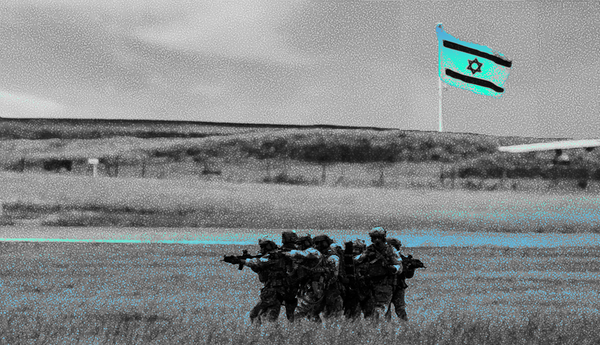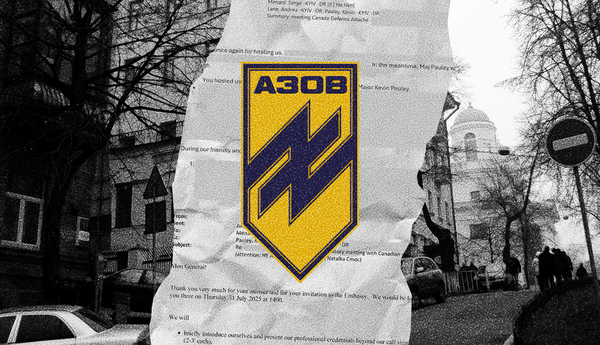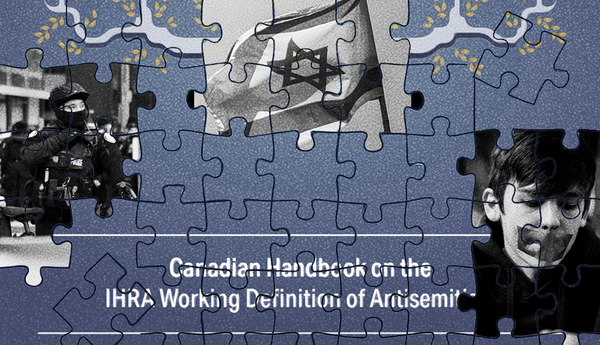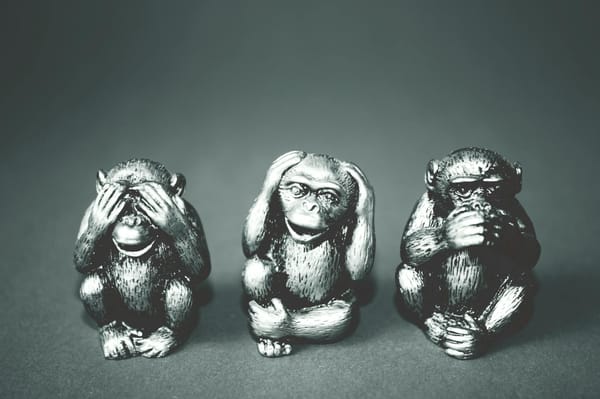More than 10,000 kilometres separate Baghdad from Wet’suwet’en territory in northwestern British Columbia. But on two consecutive frigid days in early January, the intimate connection between them was demonstrated through protests at Winnipeg’s Portage and Main intersection.
The first action, on January 10, shut down traffic with a round dance in solidarity with Wet’suwet’en land protectors fighting a proposed natural gas pipeline and threats of RCMP raids in northwest B.C. The other rally — hosted the following day at the nearby United States Consulate — brought out more than 100 people condemning the drone strike assassination, ordered by U.S. President Donald Trump, of Iranian general Qassem Soleimani at the Baghdad International Airport.
Many speakers at the second action had attended the round dance and made explicit links between the two crises. That’s because the imperialist violence unleashed once again on Iraq and Iran by the U.S. and its NATO allies comes from the same root as the colonial policing threatening the Unist’ot’en Camp.
The central objective of both the military and police forces is simple: social control, for the benefit of private capital accumulation. Their oppressive histories are intimately linked, and despite its branding as a nation of peacekeepers, Canada is at the very centre of the confluence.
It’s critical that we remember this history, in order to refine our demands for abolition of both policing and militaries.
Origins of the RCMP
To understand the deep-seated relationship between policing and militaries, we need to rewind to the beginning of Canada’s colonization efforts.
The RCMP’s origins trace back to 1873, created by then-Prime Minister John A. Macdonald, as the North-West Mounted Police in the model of the Royal Irish Constabulary. Macdonald instructed that the NWMP ‘‘should be styled Police, and have … military bearing.’’
A few years earlier, in 1870, Macdonald had sent more than 1,000 troops to crush the Métis provisional government led by Louis Riel; the assault was led by Garnet Wolseley, a veteran of imperial occupations in Burma, India and Sudan, and now the namesake of Winnipeg’s yuppie neighbourhood.
Men deployed on the “March West” in 1874 in response to the Cypress Hills Massacre — when more than 20 Assiniboine people were killed by wolfers — were outfitted in British army tunics and rode as a military regiment; contrary to the myth that the NWMP were created to protect Indigenous people from American whiskey traders, their origins long predated the massacre.
The NWMP’s mandate was the same as the British presence in Ireland: to crush resistance and secure sovereignty. This meant the imposition of so-called “civilization” on autonomous nations and destruction of Indigenous political orders, most brutally represented by the NWMP’s crushing of the North-West Rebellion in 1885 and hanging of Riel. (The national police often hanged Indigenous people during this era, including two Inuit men in 1923 to assert Canadian sovereignty in the Arctic).
Scholars have argued that these efforts must be understood simultaneously as “colonial and international.” The only way that we can interpret this history as purely “domestic” in scope, or related to policing rather than military, is if we accept the presuppositions of colonial doctrine. Settlers were — and still are — foreign invaders.
Through the second half of the 19th century, the Canadian government was battling another supposed foreign policy threat: Irish nationalists. The Dominion Police, a secret police force and another predecessor to the RCMP, infiltrated meetings held by Fenian radicals and intercepted their mail at the border. Scholars have argued this supposed threat “provided the impetus to normalize the use of spies and spymasters as part of the federal civil service.”
Meanwhile, South Asian “agitators” in B.C. who demanded Indian independence and opposed Ottawa’s proposed deportation of their community to British Honduras (now Belize) were closely surveilled by secret police.
Other colonial powers took notice of how Canada was establishing policing. The South African Constabulary, founded in 1900 during the Second Boer War, was explicitly inspired by the NWMP. A large number of Canadians were recruited to join the constabulary to help suppress the Boer resistance, led by an NWMP officer that had participated in the crushing of the Fenian raids and Métis resistance.
Colonial occupation was militaristic by nature, seeking to dominate Indigenous territory and suppress dissent from migrants organizing to end British rule of their homelands. The hard distinction between policing and military was nominal at best from the start.
This blurring was further entrenched with the so-called “professionalization” of policing throughout North America in the 20th century, which applied lessons learned from colonial occupations in the Philippines, Nicaragua and Haiti to suppress protests, riots and guerilla warfare. Local policing was further globalized by U.S. President John F. Kennedy’s Office of Public Safety, which trained and equipped police forces in more than 50 countries as a stopgap against communist insurrection without unpopular military occupations.
Peacemaking, for who?
Canada’s peacekeeping mythology rests in part on supposedly staying out of invasions such as Vietnam and Iraq. But Canada has followed the American example of control through local policing for many decades.
Since 1989, when 100 cops travelled to Namibia to train its police force, Canada has deployed almost 4,000 police officers to dozens of countries. The RCMP proudly describes on its website that they “help rebuild or strengthen police services in countries experiencing conflict or upheaval. Through police participation in these missions, Canada commits to building a more secure world.”
What this summary fails to mention is that many such conflicts — including the NATO-led decimation of Libya — are caused in large part because of Western imperialism, and that these missions are “building a more secure world” for capital, not people.
Jeffrey Monaghan, assistant professor of Carleton’s Institute for Criminology and Criminal Justice, has written extensively about Canada’s use of “security aid” to manage strategic interests in Global South countries. Specific objectives he has identified include “restricting unwanted migrants from these localities, encouraging economic development, and minimizing disruptions to global trade circulations.”
Canadian police are central to this process, which takes on many different forms. Monaghan wrote in his 2017 book “Security Aid: Canada and the Development Regime of Security” that “security innovators” from the RCMP and Canadian Border Services Agency (CBSA) helped train border officials in Southeast Asia to deter migrants from leaving to Canada. In Iraq, Canada has provided a constant deployment of police trainers in the areas of firearms instruction and paramilitary training. Similar efforts have been made in Ukraine, Palestine and Mali, which just happens to have 70 Canadian gold mining companies operating within its borders.
Canadian companies also benefit from selling security equipment to police departments in other countries, assisted by the operations of the Canadian Commercial Corporation (CCC) — a Crown corporation that “supports the growth of international trade by helping Canadian exporters gain access to foreign government procurement markets.”
Monaghan described how the CCC ensured that corporations were able to sell policing equipment to Afghanistan, Colombia, Jamaica and countries throughout Africa, including Senegal, Burkina Faso, Uganda, and South Africa.
Canadian companies are profiteering from the “professionalization” of police in Global South countries that are, above all, dealing with the brutal fallout from Western imperialism.
While training police to prevent “illicit activities” might sound like a net positive, these collaborations are done for the sole purpose of benefiting “stability” for global capitalism. There’s no better example of this than Canada’s horrifying actions in Haiti.
A forgotten coup
Canada’s complicity in “regime change,” better understood as ousting leaders of Global South countries for not being subservient enough to Western demands, has been on full display as of late in Venezuela and Bolivia.
Less well remembered is Canada’s role in the 2004 coup in Haiti, which included helping plan the event at the “Ottawa Initiative on Haiti” in January 2003, and gutting foreign aid to undermine support for the left-leaning, democratically elected president Jean-Bertrand Aristide, who had hiked the minimum wage and demanded $22 billion in reparations from France. The coup was followed by massacres, repression and a devastating cholera outbreak that killed thousands.
Canada’s financing and training of the Haitian police was central to the coup’s success. Since the coup, Canada has spent more than $100 million on security aid to the brutalized country, mostly ending up in the police, prison and border system.
RCMP officers — including veterans of counter-insurgency training in Iraq — have long led the United Nations civilian police force, whose mandate was to train the Haitian National Police (HNP). The HNP has been heavily criticized by human rights organizations for its role in executions, torture, sexual assault, kidnappings and violent suppression of dissent. RCMP officials defended the HNP’s killing of nine Aristide supporters during a 2005 demonstration, stating it was an “‘unauthorized, illegal demonstration.”
Monaghan wrote extensively about how Canada funded significant prison expansions in Haiti. While these investments were ostensibly to improve prison conditions by lessening crowding, scholars have identified a so-called “Haitian paradox” in which greatly increased carceral powers have led to a worsening of penal conditions.
In response to a wave of protests in late 2018 calling on the removal of the Western-backed president, Canada reiterated its support for the government and its police force despite the use of lethal force against demonstrators.
This wasn’t surprising, of course, given that Canada had helped train, arm and support the police force. Who needs an occupying army when you can just control the police?
Come full circle
Meanwhile, militaristic policing never ended in Canada, especially against Indigenous communities.
Police played central roles in a series of raids on Indigenous land defenders throughout the 1990s, including the Oka Crisis of 1990 and Gustafsen Lake standoff of 1995, the latter of which became the largest paramilitary operation in the province’s history, involving at least 400 RCMP officers. That same year, an Ontario Provincial Police officer shot and killed Dudley George, an Ojibwa protester who was reoccupying land stolen from the First Nation by the federal government using the War Measures Act during the Second World War.
The massive crackdown on G20 protests in Toronto in 2010 led to more than 1,000 arrests and widespread condemnation from international civil liberties organizations. Tear gas was used for the first time in Toronto’s history, while military helicopters circled above. The head of the Toronto Police Service at the time, Bill Blair, is now the federal minister of public safety.
Meanwhile, the Department of Defence has been dumping “surplus donations” of military equipment on police departments, including night vision goggles and “demilitarized” light armoured vehicles used in Afghanistan. The reliance of police departments on SWAT teams to perform “routine police work,” such as serving warrants and enforcing traffic, has skyrocketed in recent years.
Whatever line ever existed between policing and militarism has been effectively eliminated.
But it’s not enough to simply “demilitarize” the police by taking away their assault rifles and armoured vehicles, or even to disarm them entirely, as called for by some reformers. As demonstrated throughout history, the objective of policing has always been fundamentally militaristic in nature. Both institutions exist to assert social control via displacement, dispossession, incarceration and lethal force.
This is true of Western imperialist violence in Iraq, Haiti and Bolivia, as well as at Unis’tot’en and in the streets of downtown Winnipeg, where police have killed at least seven people in 2019, along with shooting a 16-year-old Indigenous boy multiple times.
We must stand united and organize collectively against the intersecting crises of police violence, imperialist aggression, climate crisis and more. Critical to the success of these struggles is recognizing the linkages between them, as well as the central role that Canada continues to play in their proliferation.
If we continue fighting against these oppressions, we may one day live in a world in which sovereign communities and nations can determine their own destinies free of violent repression.
CORRECTION: This article has been updated to note that the Oka Crisis took place in 1990. Passage regrets this error.






